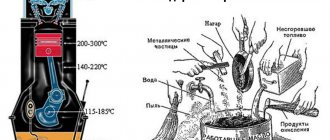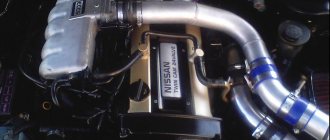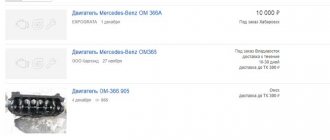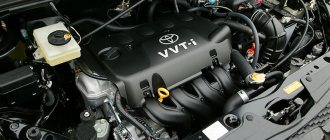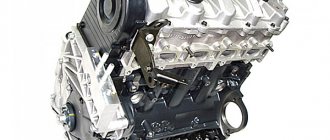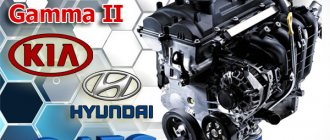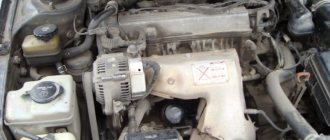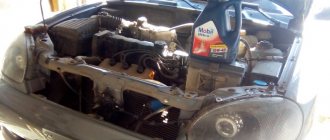The GA14DE engine was produced from 1992 to 2001. Used in Nissan Sunny N14, Nissan Sentra B14, Almera/Pulsar N15. The design of the engine had a significant improvement in the preparation of the air-fuel mixture: instead of a carburetor, the injection function began to be performed by an injection system. This change is associated with tightening control over the emission of harmful substances. Electronic injection control allows you to reduce emissions and control the operation of sensors through the on-board computer.
The GA14DE is rusty in places, but the engine is over 20 years old
Engine characteristics GA14DE
The cylinder block is made of cast iron, the cylinder head is made of aluminum. Fuel - gasoline.
Decoding the code:
- GA-family
- Volume 14 - 1.4 liters
- D-DOHC (double camshafts)
- E-multipoint fuel injection
Specifications:
- power - 87 hp. With. at 6000 rpm
- torque - 116 Nm at 4000 rpm
- location - front, transverse
- volume -1.4 l, (1392 cm)
- number of cylinders - 4
- cylinder diameter - 73.6 mm
- piston stroke - 81.8 mm
- compression ratio - 9.5
- number of valves per cylinder - 4
- timing drive - chain
- fuel system - multipoint injection
- environmental class - euro 1−2
resource - approximately 400,000 km
Fuel consumption
Almera N15
For an Almera N15 sedan with a 5-speed manual transmission, GA14DE gasoline consumption per 100 km is:
- city - 9.2 l
- highway - 5.8 l
- mixed cycle - 7 l.
Nissan Almera engine - how much oil
First generation N15, 1995-2000
Almera N15 is the successor to the popular Sunny model, which has been produced since the 1960s. The new car had three body types - a three- and five-door hatchback, as well as a 4-door sedan. The version for the Japanese market was renamed Nissan Pulsar. The car received an original angular design with a low body, which significantly improved aerodynamics. In addition, because of this, the three-door version looked like a sports coupe. The engine range for all versions consisted of 1.4 and 1.6 liter gasoline engines (87-99 hp), as well as a 75-horsepower 2.0 liter diesel engine. Later, a “charged” modification of the GTi appeared with a 2.0 l engine (143 hp) and aerodynamic body kits. In 1998, restyling took place.
Also read: Engine oil for Nissan Murano engine
Gasoline engines 1998-2000
- 1.4 87 l. With. (GA14DE), oil volume - 3.2 liters, tolerance and viscosity: API-SG, SH, SJ; SAE 5W-40, 5w-30, 10W-30, 10W-40, 0W-30, 0W-40
- 1.6 99 l. With. (GA16DE), oil volume - 3.2 liters, tolerance and viscosity: API-SG, SH, SJ; SAE 5W-40, 5w-30, 10W-30, 10W-40, 0W-30, 0W-40
Second generation N16, 2000-2012
The second generation Almera was designed with the European market in mind. Designers radically changed the design concept of the new model. Thus, the angular shapes were replaced by streamlined and dynamic outlines, but at the same time, the height of the body increased. The interior has also undergone major changes, but primarily the quality of materials has improved.
The hatchback of the same name was assembled in the UK, and the sedans were assembled in Japan. The Almera II is based on the Renault-Nissan Alliance platform, which was also used to create the Primera and Almera Tino models. The engine range included 1.5 and 1.8 liter petrol engines (from 90 to 115 hp), as well as a single 110 hp 2.2 liter diesel engine. A French Renault 1.5 liter diesel engine was also available. Transmissions: manual gearbox-5 or 4-speed automatic.
Gasoline engines 2000-2006
- 1.5 90 l. With. (QG15DE), oil volume - 2.7 liters, tolerance and viscosity: API-SJ, SH; SAE 5W-40, 5w-30, 10W-30, 10W-40, 0W-30, 0W-40
- 1.5 98 l. With. (QG15DE), oil volume - 2.7 liters, tolerance and viscosity: API-SJ, SH; SAE 5W-40, 5w-30, 10W-30, 10W-40, 0W-30, 0W-40
- 1.8 114 l. With. (QG18DE), oil volume - 2.7 liters, tolerance and viscosity: API-SJ, SH; SAE 5W-40, 5w-30, 10W-30, 10W-40, 0W-30, 0W-40
- 1.8 116 l. With. (QG18DE), oil volume - 2.7 liters, tolerance and viscosity: API-SJ, SH; SAE 5W-40, 5w-30, 10W-30, 10W-40, 0W-30, 0W-40
Also read: Engine oil for Opel Vectra engine
Third generation G11, 2012-2019
Almera III is built on the VO platform, previously used to produce the first generation Renault Logan. From the Logan, the Japanese car also inherited a similar interior design, which did not differ in the level of equipment. At the same time, the car received an original appearance in the style of the flagship Teana sedan, thanks to which it became very popular on the Russian market. The car was in demand primarily among family buyers, who valued the Almera for its spacious interior and spacious trunk. The car was equipped with a 1.6 Logan engine with a power of 102 hp. With. It could be combined with a manual or automatic transmission. In 2018, the model left the Russian market due to the fact that Nissan decided to sell only crossovers in the Russian Federation.
1.6 102 l. With. (K4M), oil volume - 4.8 liters, tolerance and viscosity: API-SM, SN; SAE 5W-40, 5w-30, 10W-30, 10W-40, 0W-30, 0W-40
Technical features and modifications
GA14 series engines have a number of modifications. They have a design thought out by Japanese engineers, consisting of a cast iron cylinder block, aluminum cylinder head and crankcase.
The GA14 family is represented by three commercially produced engines. GA14S is a single camshaft carburetor engine with 12 valves. Power - 79l. With. Torque - 111 Nm. Installed on Nissan Sunny N13. The car has been produced since 1983.
Engine carburetor power supply diagram
GA14 DS - index D means electronic carburetor control . Two camshafts controlled by a chain drive. Power - 75l. With. Torque - 112 Nm Installed on Nissan Sunny N14.
GA14DE - technical characteristics are described in detail above. An improved electronic injection system has reduced gasoline consumption. The engine was installed on Nissan Sunny B12, B13, Almera N15.
Scheme of multi-point (injection) injection
Service
Monitor the oil and coolant levels as often as possible. Do not allow the engine to overheat.
The fuel that is burned inside produces a lot of heat. Maintaining the temperature within proper limits is the job of the cooling system. Lack of coolant due to a leak will cause the engine to overheat and cause serious complications.
GA14 motors are recommended to be serviced and repaired using a special manual, which contains the characteristics of the components and step-by-step instructions for performing repair work. The engine compartment allows you to perform most maintenance and repair work without removing the engine.
The GA14DE pump is an important element of the cooling system. It is better to change when replacing timing chains
The oil is changed every 10,000 km; GA14DE is not very demanding on the quality of the lubricant.
But pouring poor lubricating fluid or changing it rarely will significantly reduce the life of the power plant. Change the filter along with changing the oil. Antifreeze is changed every two years or after 40,000 km. Spark plugs are changed every 30,000 km.
After 50,000 km, the thermal clearances of the valves are adjusted and the appropriate washers are selected. In case of serious damage requiring major repairs, the engine is taken to a service station by experienced mechanics. It is also recommended to proceed when replacing both timing chains. They will not require replacement before 250 thousand km.
What oil to use for the Nissan Almera engine
Original
The manufacturer of the Nissan Almera recommends branded engine oil Nissan Motor Oil 0W-30 (art KE900-90132) or Nissan Strong Save XE Special SM 5W-30 (art KLAM2-05304). As for viscosity, it is selected depending on temperature conditions. So, for all-season use, a viscosity of 10W-40, 10w-30 or 5W-40 is suitable. Mostly in summer it is recommended to fill in 20W-40 or 25W-50, and in winter 0W-30, 0w-40 or 5W-30 is more suitable.
Unoriginal
Owners of Nissan Almera cars prefer proven motor oils from well-known brands with a good reputation. Among them are Kixx, Shell, Mannol, Valvoline, Liqui Moly, Castrol, Mobil, Motul, etc. In addition, when choosing a suitable product, you must pay attention to the API tolerance indicated in the oil characteristics. This parameter is selected depending on the year of manufacture of the car, as well as the type of engine. Below are the optimal oil parameters for Almera based on these criteria.
- First generation: for gasoline models produced in 1995. We recommend semi-synthetic all-season oil with parameters 10W-30 and API-SG. For 2000 cars, semi-synthetic API-SJ is suitable.
- Second generation: for petrol versions of Almera 2000. All-season semi-synthetic 10W-30 with API-SJ approval is recommended. This also applies to cars manufactured in 2006.
- Third generation: in gasoline Almera engines 2012. fill in all-season semi-synthetic 15W-40 API-SM, and for more recent models after 2013. Pure synthetics API-SN are suitable.
- Idemitsu Euro Spec 5W-40 art 1849041
- Shell Helix HX8 Synthetic 5W-30 art 550046372
- ZIC XQ 5W-40 API SM art 167006
- NGN Gold 5W-40 art V172085302.
Also read: Motor oil for Suzuki Vitara engine
Disadvantages, weaknesses and advantages of GA14DE
GF14S and GA14DS engines stall due to problems with carburetors; the holes become clogged if all kinds of meshes, jets, and filters are not cleaned in time. The maintenance work is not difficult; drivers must clean this unit on their own.
Timing chains GA14DE
The idle speed fluctuates. This indicates a malfunction of the idle air valve (IAC) or the mass air flow sensor (MAF).
Critical breakdowns manifest themselves in increased oil consumption in cars with high mileage. Perhaps the oil scraper rings are stuck or there is a problem with the valve stem seals or gaskets. If the problem of oil leakage is critical, then diagnostics and maybe major repairs are needed.
Advantages
Positive characteristics:
- maintainability
- reliability of timing chains, service life of at least 250,000 km.
- durability of GA14DE - 300-400 thousand km without major repairs.
- electronic injection saves fuel consumption
- high performance characteristics for engines of their age.
Cylinder block GA14DE
Reliability of the QG15DE engine
How is such a concept as the reliability of a power unit expressed? It’s very simple, it means whether the driver will be able to get to his destination with any sudden breakdown. Not to be confused with service life.
The QG15DE motor is quite reliable, which is due to the following factors:
- Fuel injection system. The carburetor, due to the lack of electronic components, allows you to win in acceleration and jerking from a standstill, but even ordinary clogging of the jets will lead to a stalled engine.
- Cast iron cylinder block and cylinder head cover. A material with a fairly long service life, but does not like sudden temperature changes. Engines with a cast iron block should only be filled with high-quality coolant, preferably antifreeze.
- High compression ratio with small cylinder volume. The conclusion is a longer engine life without loss of power.
The engine life was not indicated by the manufacturer, but from reviews of car enthusiasts on the Internet we can conclude that it is at least 250,000 km. With timely maintenance and non-aggressive driving, it can be extended up to 300,000 km, after which it is necessary to carry out a major overhaul.
The QG15DE power unit is absolutely not suitable as a basis for tuning. This motor has average technical characteristics and is designed only for a calm and smooth ride.
